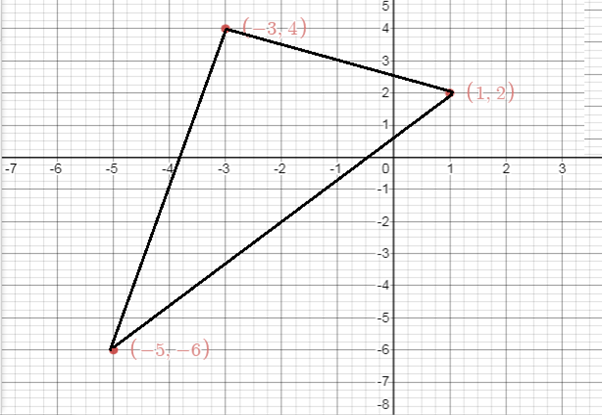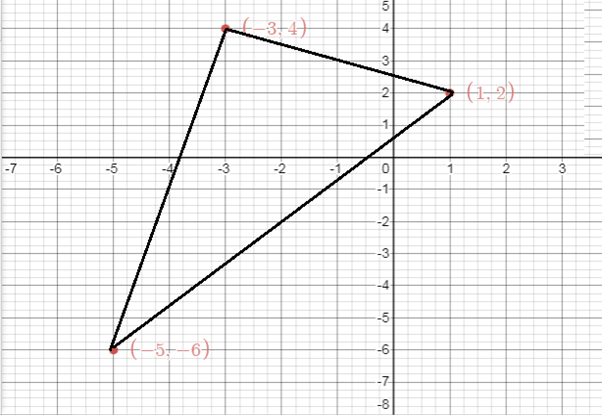
Find the area of the triangle whose vertices are \[\left( {1,2} \right),\left( { - 3,4} \right)\] and \[\left( { - 5, - 6} \right)\].


Answer
549k+ views
Hint: When coordinates are given in the question and when we have to find the area of the triangle we use the formula, \[\dfrac{1}{2}\left| {{x_1}\left( {{y_2} - {y_3}} \right) + {x_2}\left( {{y_3} - {y_1}} \right) + {x_3}\left( {{y_1} - {y_2}} \right)} \right|\] where \[\left( {{x_1},{y_1}} \right),\left( {{x_2},{y_2}} \right)\] and \[\left( {{x_3},{y_3}} \right)\] are the vertices of the triangle, and this is derived by finding the length of the base of the triangle and its height using the distance formula.
Complete step-by-step answer:
Given the vertices of the triangle are \[\left( {1,2} \right),\left( { - 3,4} \right)\] and \[\left( { - 5, - 6} \right)\].
This is represented in the given diagram,

Let the vertices of the triangle are represented as,
$\Rightarrow$ \[\left( {{x_1},{y_1}} \right),\left( {{x_2},{y_2}} \right)\]and\[\left( {{x_3},{y_3}} \right)\],
And the area of the triangle can be determined by using the formula,
$\Rightarrow$ \[\dfrac{1}{2}\left| {{x_1}\left( {{y_2} - {y_3}} \right) + {x_2}\left( {{y_3} - {y_1}} \right) + {x_3}\left( {{y_1} - {y_2}} \right)} \right|\],
Now, now substituting the values in the formula we get,
Area of triangle\[ = \dfrac{1}{2}\left| {{x_1}\left( {{y_2} - {y_3}} \right) + {x_2}\left( {{y_3} - {y_1}} \right) + {x_3}\left( {{y_1} - {y_2}} \right)} \right|\],
Now here, \[{x_1} = 1,{y_1} = 2,{x_2} = - 3,{y_2} = 4,{x_3} = - 5,{y_3} - 6\],
Then the formula will be,
$\Rightarrow$ Area of triangle\[ = \dfrac{1}{2}\left| {{x_1}\left( {{y_2} - {y_3}} \right) + {x_2}\left( {{y_3} - {y_1}} \right) + {x_3}\left( {{y_1} - {y_2}} \right)} \right|\]
$\Rightarrow$ Area of triangle\[ = \dfrac{1}{2}\left| {1\left( {2 - ( - 6)} \right) + ( - 3)\left( { - 6 - 2} \right) + ( - 5)\left( {2 - 4} \right)} \right|\],
Now simplifying inside the brackets we get,
$\Rightarrow$ Area of triangle\[ = \dfrac{1}{2}\left| {1\left( {2 + 6} \right) + ( - 3)\left( { - 8} \right) + ( - 5)\left( { - 2} \right)} \right|\],
$\Rightarrow$ Area of triangle\[ = \dfrac{1}{2}\left| {1\left( 8 \right) + ( - 3)\left( { - 8} \right) + ( - 5)\left( { - 2} \right)} \right|\],
Now multiplying inside the absolute value we get,
Area of triangle\[ = \dfrac{1}{2}\left| {8 + 24 - 10} \right|\],
Now adding inside the absolute value get,
$\Rightarrow$ Area of triangle\[ = \dfrac{1}{2}\left| {32 - 10} \right|\]
$\Rightarrow$ Area of triangle\[ = \dfrac{1}{2}\left| {22} \right|\],
$\Rightarrow$ Area of triangle\[ = 11\],
Therefore the area of triangle whose vertices are is \[\left( {1,2} \right),\left( { - 3,4} \right)\]and\[\left( { - 5, - 6} \right)\]\[ = 11\]sq. units.
\[\therefore \] The area of triangle whose vertices are is \[\left( {1,2} \right),\left( { - 3,4} \right)\]and\[\left( { - 5, - 6} \right)\]\[ = 11\]sq. Units.
Note:
In these types of questions students may get confused and make mistakes in substituting the values in the area formula as there are three points they should note the vertices in the formula and also there is a chance that the calculations mistakes can be done, so students should do calculations carefully.
Complete step-by-step answer:
Given the vertices of the triangle are \[\left( {1,2} \right),\left( { - 3,4} \right)\] and \[\left( { - 5, - 6} \right)\].
This is represented in the given diagram,

Let the vertices of the triangle are represented as,
$\Rightarrow$ \[\left( {{x_1},{y_1}} \right),\left( {{x_2},{y_2}} \right)\]and\[\left( {{x_3},{y_3}} \right)\],
And the area of the triangle can be determined by using the formula,
$\Rightarrow$ \[\dfrac{1}{2}\left| {{x_1}\left( {{y_2} - {y_3}} \right) + {x_2}\left( {{y_3} - {y_1}} \right) + {x_3}\left( {{y_1} - {y_2}} \right)} \right|\],
Now, now substituting the values in the formula we get,
Area of triangle\[ = \dfrac{1}{2}\left| {{x_1}\left( {{y_2} - {y_3}} \right) + {x_2}\left( {{y_3} - {y_1}} \right) + {x_3}\left( {{y_1} - {y_2}} \right)} \right|\],
Now here, \[{x_1} = 1,{y_1} = 2,{x_2} = - 3,{y_2} = 4,{x_3} = - 5,{y_3} - 6\],
Then the formula will be,
$\Rightarrow$ Area of triangle\[ = \dfrac{1}{2}\left| {{x_1}\left( {{y_2} - {y_3}} \right) + {x_2}\left( {{y_3} - {y_1}} \right) + {x_3}\left( {{y_1} - {y_2}} \right)} \right|\]
$\Rightarrow$ Area of triangle\[ = \dfrac{1}{2}\left| {1\left( {2 - ( - 6)} \right) + ( - 3)\left( { - 6 - 2} \right) + ( - 5)\left( {2 - 4} \right)} \right|\],
Now simplifying inside the brackets we get,
$\Rightarrow$ Area of triangle\[ = \dfrac{1}{2}\left| {1\left( {2 + 6} \right) + ( - 3)\left( { - 8} \right) + ( - 5)\left( { - 2} \right)} \right|\],
$\Rightarrow$ Area of triangle\[ = \dfrac{1}{2}\left| {1\left( 8 \right) + ( - 3)\left( { - 8} \right) + ( - 5)\left( { - 2} \right)} \right|\],
Now multiplying inside the absolute value we get,
Area of triangle\[ = \dfrac{1}{2}\left| {8 + 24 - 10} \right|\],
Now adding inside the absolute value get,
$\Rightarrow$ Area of triangle\[ = \dfrac{1}{2}\left| {32 - 10} \right|\]
$\Rightarrow$ Area of triangle\[ = \dfrac{1}{2}\left| {22} \right|\],
$\Rightarrow$ Area of triangle\[ = 11\],
Therefore the area of triangle whose vertices are is \[\left( {1,2} \right),\left( { - 3,4} \right)\]and\[\left( { - 5, - 6} \right)\]\[ = 11\]sq. units.
\[\therefore \] The area of triangle whose vertices are is \[\left( {1,2} \right),\left( { - 3,4} \right)\]and\[\left( { - 5, - 6} \right)\]\[ = 11\]sq. Units.
Note:
In these types of questions students may get confused and make mistakes in substituting the values in the area formula as there are three points they should note the vertices in the formula and also there is a chance that the calculations mistakes can be done, so students should do calculations carefully.
Recently Updated Pages
Master Class 12 Business Studies: Engaging Questions & Answers for Success

Master Class 12 Economics: Engaging Questions & Answers for Success

Master Class 12 English: Engaging Questions & Answers for Success

Master Class 12 Maths: Engaging Questions & Answers for Success

Master Class 12 Social Science: Engaging Questions & Answers for Success

Master Class 12 Chemistry: Engaging Questions & Answers for Success

Trending doubts
Write a letter to the principal requesting him to grant class 10 english CBSE

Why is there a time difference of about 5 hours between class 10 social science CBSE

What is the median of the first 10 natural numbers class 10 maths CBSE

The Equation xxx + 2 is Satisfied when x is Equal to Class 10 Maths

Discuss the main reasons for poverty in India

10 examples of evaporation in daily life with explanations




